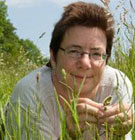The findings, published in the journal Ecology, could help conservationists manage and protect rare and threatened habitats.
Yellow Rattle
Ecologists from the Universities of York, Sussex and Lincoln discovered that the parasitic plant Rhinanthus minor, also known as Yellow Rattle, boosts the diversity of surrounding vegetation and animal life.
R. minor belongs to a group of plants known as “hemiparasites”. These plants absorb nutrients from other plants, but they can also produce their own food through photosynthesis.
The scientists studied plants and invertebrates in areas where Yellow Rattle was removed, left at natural densities, or increased in abundance. The research took place at Castle Hill National Nature Reserve in Sussex.
Positive impact
The results show for the first time the positive effects of a ‘vampire’ plant further up the food chain – not only on other plants, but also on animals feeding on dead plant and animal matter, herbivores and their predators.
The researchers found that while there was a lower mass of plants in the areas where the 'vampire' plant was most abundant, the diversity of species that grew near Yellow Rattle actually increased. The number of invertebrates almost doubled.
Conservation
Lead author, Professor Sue Hartley, of the Department of Biology at York and Director of the York Environmental Sustainability Institute, said: “This was a really unexpected finding. Although hemi-parasites are known to increase the diversity of other plants in the community by suppressing the dominant species they parasitize and so allowing other plants to flourish, none of us predicted there would be such dramatic and positive impacts on other components of the grassland community.
“R. minor increased the abundance of all sorts of animals including snails, woodlice, butterflies, wasps and spiders. This is an important finding for the conservation and management of these chalk grassland communities, which are exceptionally species rich but also rare and threatened.”
Co-researcher Dr Libby John, Head of the School of Life Sciences at the University of Lincoln, said: “Overall, our findings demonstrate that parasitic plants can have dramatic and lasting impacts on abundance, richness and diversity across multiple trophic levels within semi-natural grassland communities. Our results also illustrate that keystone species such as R. minor can have both negative and positive impacts on other species.”
The text of this article is licensed under a Creative Commons Licence. You're free to republish it, as long as you link back to this page and credit us.





